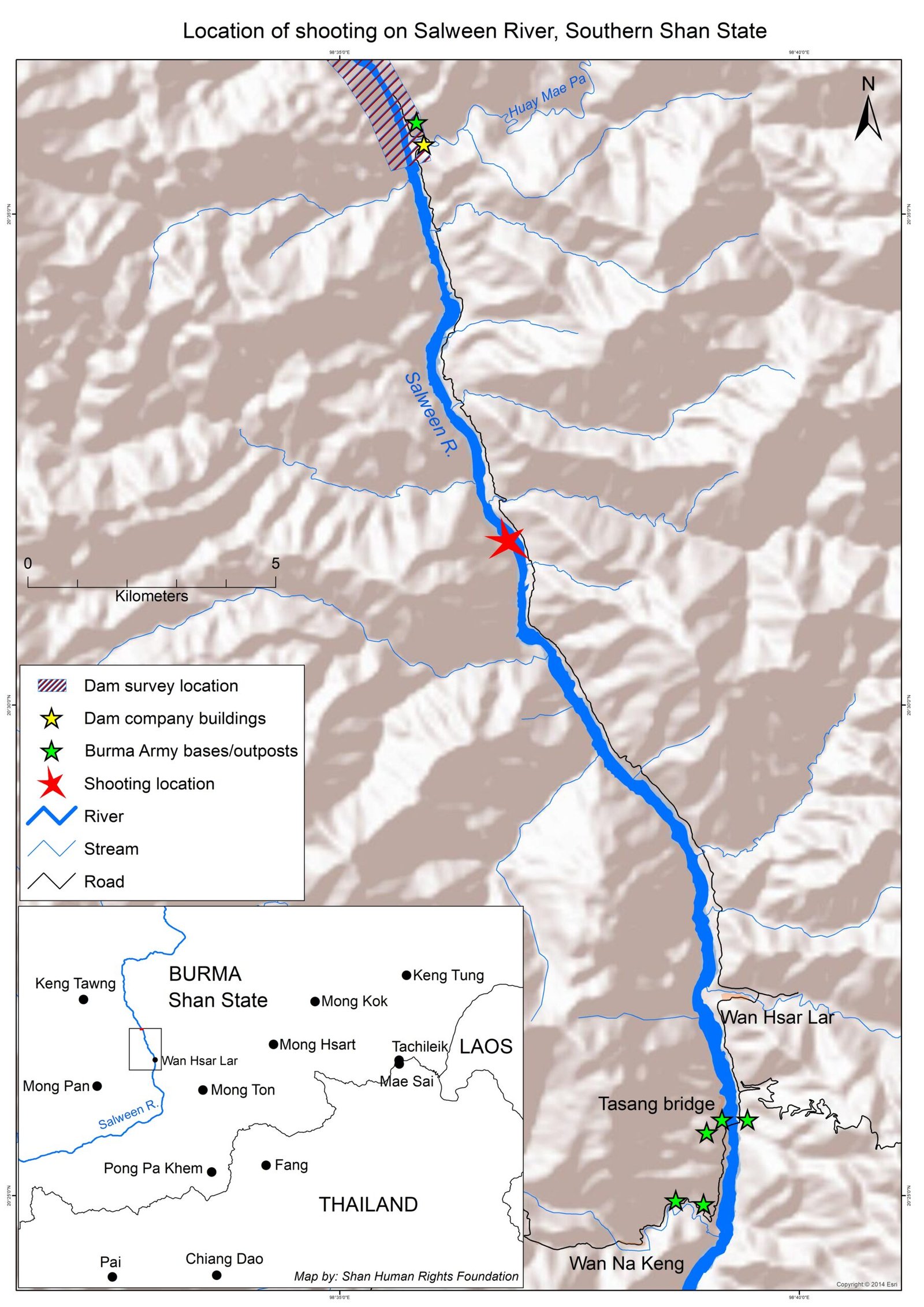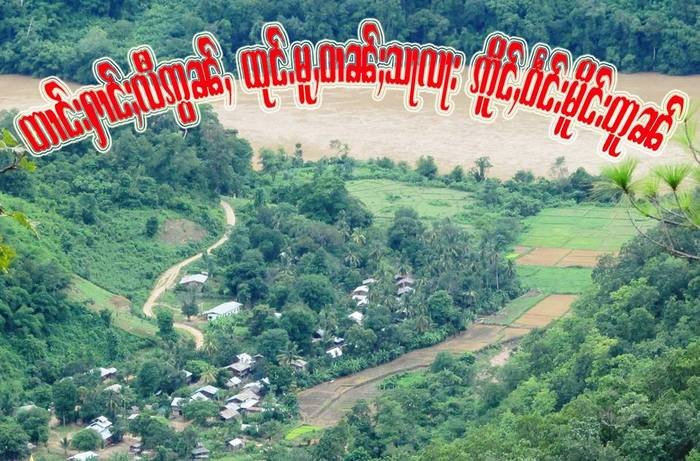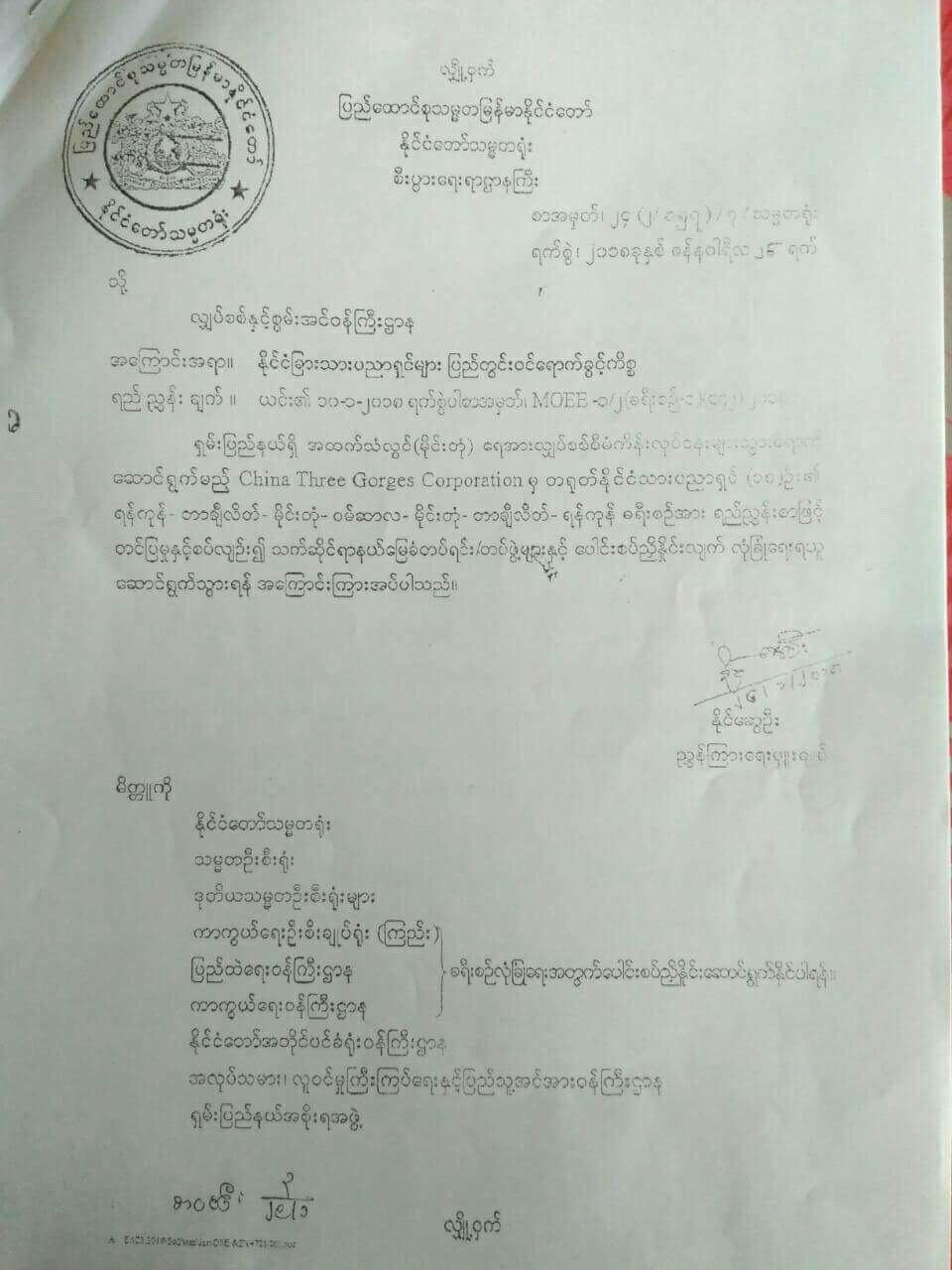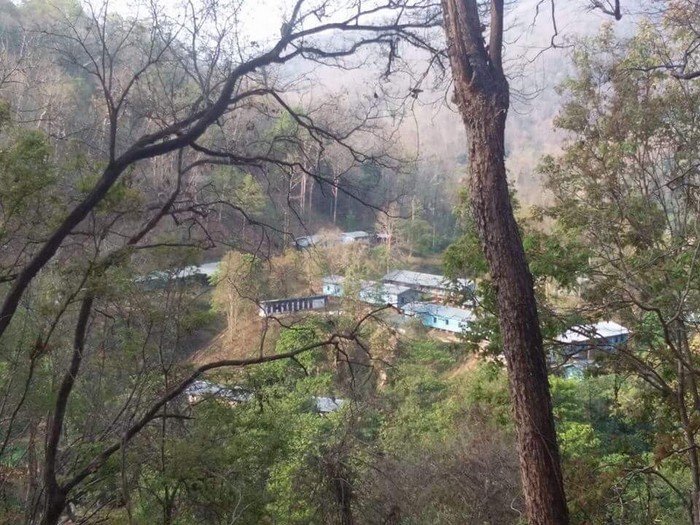Update by Action for Shan State Rivers
May 11, 2018
Fatal attack on boat carrying civilians in southern Shan State highlights insecurity of planned Salween dams
On April 10, 2018, a boat travelling along the Salween was shot at, fatally wounding one man and injuring a nine-year-old boy, near where a group of Chinese engineers have been conducting surveys for the giant Mong Ton dam in southern Shan State.
On April 9, a group of nine residents (four men, four women and one boy) of Wan Hsar Lar village, Mong Ton township, travelled from their village by boat to a logging camp upstream along the Salween, and spent the night there. The next day, five people returned by boat along the river. Suddenly, at about 2 pm, there was rifle fire from the western riverbank, about six miles upstream from Wan Hsar Lar. A 42-year-old male passenger called Sai Pe Di was hit in the pelvis, and a 9-year-old boy – the son of the boat driver, Sai Tun Ngwe – was hit in the right calf.
The terrified boat driver immediately turned off the motor on the boat, fearing further attack, and let it float downriver till reaching Wan Hsar Lar, where they arranged for a car to take the injured villagers to Mong Ton Hospital. However, Sai Pe Di was so badly injured that he died before reaching the car. The boy was taken to Mong Ton Hospital where he was treated for his leg wound. He is still receiving treatment there.
Sai Pe Di’s body was taken to his house in Wan Hsar Lar. The next day, at midday, three Burma Army soldiers based near Ta Sang Bridge came to Sai Pe Di’s house and asked questions about the incident. His body was left at his house for two nights. On April 12, police from Mong Ton town came and took his body for a post mortem at Mong Ton hospital, even though his relatives did not want his body to be taken away. After the post mortem, the police let Sai Pe Di’s relatives take his body and have it cremated at Mong Ton cemetery that day.

Sai Pe Di belonged to a local Burmese government militia, under the Mong Kang Htanay Pyithusit, based at Mae Ken in southern Mong Ton, and led by Tin Win. Sai Pe Di was married to Nang Neung, and had one daughter called Nang Kham Khin. He had been running a small logging business, employing local workers. He was wearing a green militia uniform shirt when he was shot. Formerly, when he had gone to the jungle to do logging, he had not worn his uniform, but had started wearing it after a group of Chinese engineers arrived in the area in February 2018 to carry out surveying for the Mong Ton dam. According to other villagers, there was tightened security after the Chinese arrived, and he felt it was safer to wear his Burmese militia uniform.

No one has claimed responsibility for the shooting, which has terrified local villagers. There are about 50 houses in Wan Hsar Lar village. Almost all are Shan.
Tight security for Chinese dam surveyors
On Jan 26, 2018, U Naing Swe Oo, the Director General of the President’s Office sent a letter (headed “secret”) to the Ministry of Electricity and Energy (MOEE) asking for military security to be arranged for 10 Chinese experts from the China Three Gorges Corporation who would be travelling to the area to implement the Mong Ton hydropower project. Copies were sent to the Office of the Commander in Chief, the Defence Ministry and Home Ministry, who were spec ifically asked to cooperate on providing security for the experts. The letter said that the Chinese would travel from Yangon to Tachilek, then via Mong Ton to Wan Hsar Lar.

In February 2018, villagers in Wan Hsar Lar saw about 20 Chinese arriving in several car convoys, which drove through their village to a site called Mae Pa, about twelve miles north of Wan Hsar Lar. They came in SURF cars driven from Tachilek. Villagers said that some of the cars were owned by the International Group of Entrepreneurs Company, the Burmese company investing in the Mong Ton dam.

Villagers described tight military security for the Chinese surveyors. They stayed at the worksite, and did not come down to Wan Hsar Lar. They were guarded by Burma Army troops of Light Infantry Battalion 580 (under Military Operations Command 14 based at Mong Hsat) and government militia forces (of the Mong Kang Htanay Pyithusit and Border Guard Force 1007). When they travelled out to work along the river, villagers saw two Burma Army soldiers for each Chinese surveyor.
Wan Hsar Lar villagers said they received no benefits from the arrival of the survey team. No local villagers were employed at the worksite, and no local cars were hired by them. All food, including vegetables, for the surveyors was purchased at Tachilek, not Wan Hsar Lar, and transported to the worksite. “All we got from them was dust,” (when the cars drove along dirt roads through their village) said one villager.
Local villagers were even afraid to talk about the Chinese visitors, saying that Mong Ton police had called in some villagers for questioning who had been heard talking about the Chinese team.
Background of Mong Ton dam
The Mong Ton dam is one of three dams planned on the mainstream Salween in Shan State. It was originally planned to produce 7,000 Megwatts, and, at 231 meters tall, would be the largest dam in Southeast Asia, with a reservoir covering an area about the size of Singapore, and stretching two-thirds the length of Shan State. The homes of tens of thousands of villagers would be flooded, including those living along the Nam Pang tributary in Kunhing township, whose unique ecology gave the area its name: Kunhing or “Kun Heng” means “thousand islands” in Shan.
The dam is a joint venture between China Three Gorges Corporation, Sinohydro and China Southern Grid from China (holding 56% shares in the project), the Electricity Generating Authority of Thailand International Company – EGATi (30%), the Myanmar Department of Hydropower Planning (DHPP) (10%) and Burma’s International Group of Entrepreneurs – IGOEC (4%). IGOEC is run by the family of former Industry Minister Aung Thaung, who personally brokered several ceasefire agreements in 2012 with ethnic armed groups operating along the Salween River in Shan State.
According to EGATi’s website, the project is currently being redesigned “to reduce the impact on society and environment” and is now aimed to produce 3,000 Megawatts. 90% of the electricity produced from the Mong Ton dam will be exported to Thailand. (https://www.egati.co.th/en/investment/en-mongton.html)
Local communities remain strongly opposed to the dam, and have repeatedly protested and signed petitions against it. The Committee for Shan State Unity, comprising the main Shan political parties and Shan armed groups, issued a public statement opposing the Mong Ton and other dams on the Salween on August 29, 2016, saying the dams would “threaten people’s lives, property and homes, and also destroy the ecological system,” and that “moving ahead with these dams will fuel conflict.”
The dam site and planned reservoir lie in a contested area, where the Burma Army has launched scorched earth campaigns over the past 20 years, involving mass killing, torture and rape of local villagers.
Although the Burma Army controls the main bridge across the Salween in southern Shan State at Ta Sang, and has security outposts along the river, they do not control the mountainous jungle areas on either side of the river, where several ethnic armed groups operate, including the Restoration Council of Shan State/Shan State Army (RCSS/SSA).
In recent months, there has been fighting between RCSS and the Burma Army in Mong Paeng, north of Wan Hsar Lar, and the Burma Army has arrested and tortured local villagers on suspicion of supporting the RCSS/SSA, even though it has a bilateral ceasefire and signed the Nationwide Ceasefire Agreement in 2015.
In 2011, three Chinese engineers surveying for the Mong Ton dam were kidnapped by a local armed group (whose name was never publicized), together with their interpreter. After being held for three months, they were released unharmed. (http://burmariversnetwork.org/news/china-asks-shan-army-to-chase-its-four-missing-guys)
Wake-up call to dam investors
This recent attack in broad daylight on a boat carrying civilians highlights clearly the lack of security along the Salween in southern Shan State despite ceasefires.
Although it is not known who carried out the attack, it is likely not a coincidence that it took place when the Chinese surveyors were present in the area, with heightened security.
The attack must serve as a wake-up call to the dam investors. It is far too risky to push ahead with such a large and controversial project in a war zone, where control over natural resources is one of the root causes of conflict.
Action for Shan State Rivers (ASSR) urges investors in all the dams on the Salween and its tributaries in Burma to immediately cancel plans to build these dams, which lie in contested areas. Proceeding with these dams is fuelling the decades-long conflict, and placing local civilians’ lives at increased risk.
Contact
Sai Khur Hseng +95: 926-436- 2973 (Shan, English, Burmese)
Nang Charm Tong +66: 81-603-6655 (Shan, Thai, English)
Sai Hor Hseng +66: 62- 941-9600 (Shan,English)
Sai Yord Luin +66: 97- 143-1530 (Shan,Burmese)
PDF files:

